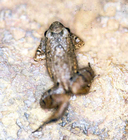|
Description
A small frog. Males 22-24 mm, females 26-27 mm. The dorsal coloration consists of scattered dark markings on a brown background. There are two well-defined
glandular dorsolateral folds on each side of the body. The distance from the eye to the snout is about one and a half times the diameter of the eye. The belly and throat are white. The lower and front surfaces of the thighs are yellowish. The iris is bronze.
Similar species: Adenomera andreae differs by the distance from the eye to the tip of the snout being only about the diameter of the eye, its glandular dorsolateral folds being fine and difficult to see with the naked eye; its pectoral region and undersides of arms being darker than the belly. The posterior region of the belly and thighs are grayish in A. andreae. Distribution and Habitat
Country distribution from AmphibiaWeb's database: Bolivia, Brazil, Colombia, Ecuador, French Guiana, Guyana, Paraguay, Peru, Suriname, Venezuela
Widespread in northern, eastern South America. Common at the edges of the Reserva Florestal Adolpho Ducke in Brazil, and in disturbed areas.Life History, Abundance, Activity, and Special Behaviors
The species is terrestrial, active by day and night, and usually found in open areas and edges of forests.
Reproduction occurs throughout the year, with a peak in the rainy season (December to May). The males call from the ground, hidden among leaves and fallen branches. Males excavate small burrows in the soil, in which the female deposits about 15 eggs in a foam nest.
The tadpoles develop in the foam nest, living exclusively on the yolk provided in the eggs. Comments
This species was featured in News of the Week 5 June 2023:
Foam nests are a unique reproductive strategy used by frogs providing eggs and larva protection from desiccation, predation, and suffocation while also aiding in fertilization and providing a food source for developing larvae. More recently, the protein and carbohydrate rich foam also has been associated with the vertical transfer of beneficial microbial communities in rhacophorid frogs. Monteiro et al. (2023) characterized the protein composition and microbiome of the nests of three Leptodactylid species: Adenomera hylaedactyla, Leptodactylus vastus, and Physalaemus cuvieri, with each representing a different spawning habitat type. They found that protein composition was species-specific and was influenced more by spawn habitat type and nest size than phylogenetic relatedness. Many of these proteins were previously unidentified. Additionally, the microbiome community of the nest was unique from the surrounding environment and the adult skin microbiome. These findings show that foam nests have a key functional role in reproduction and highlight the need for conservation efforts to protect nests from anthropic pressures, as each nest has a unique microenvironment. (Written by Ann Chang)
Originally submitted by: Albertina P. Lima, William E. Magnusson, Marcelo Menin, Luciana K. Erdtmann, Domingos J. Rodrigues, Claudia Keller, Walter Hödl (first posted 2007-12-05)
Edited by: Kellie Whittaker, Michelle S. Koo (2023-06-04)Species Account Citation: AmphibiaWeb 2023 Adenomera hylaedactyla: Dark-spotted Thin-toed Frog <https://amphibiaweb.org/species/3301> University of California, Berkeley, CA, USA. Accessed Jun 14, 2025.
Feedback or comments about this page.
Citation: AmphibiaWeb. 2025. <https://amphibiaweb.org> University of California, Berkeley, CA, USA. Accessed 14 Jun 2025.
AmphibiaWeb's policy on data use.
|
